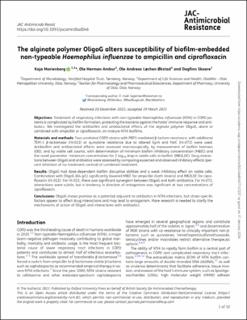| dc.description.abstract | Objectives Treatment of respiratory infections with non-typeable Haemophilus influenzae (NTHi) in COPD patients is complicated by biofilm formation, protecting the bacteria against the hosts’ immune response and antibiotics. We investigated the antibiofilm and antibacterial effects of the alginate polymer OligoG, alone or combined with ampicillin or ciprofloxacin, on mature NTHi biofilms. Materials and methods Two unrelated COPD strains with PBP3-mediated β-lactam resistance, with additional TEM-1 β-lactamase (Hi-022) or quinolone resistance due to altered GyrA and ParC (Hi-072) were used. Antibiofilm and antibacterial effects were assessed macroscopically, by measurement of biofilm biomass (OD), and by viable cell counts, with determination of minimum biofilm inhibitory concentration (MBIC) and the novel parameter ‘minimum concentration for 2 log10 drop in viable cells in biofilm’ (MB2LDC). Drug interactions between OligoG and antibiotics were assessed by comparing expected and observed inhibitory effects (percent inhibition of no-treatment control) of combined treatment. Results OligoG had dose-dependent biofilm disruptive abilities and a weak inhibitory effect on viable cells. Combination with OligoG (64 g/L) significantly lowered MBIC for ampicillin (both strains) and MB2LDC for ciprofloxacin (Hi-022). For Hi-022, there was significant synergism between OligoG and both antibiotics. For Hi-072, interactions were subtle, but a tendency in direction of antagonism was significant at two concentrations of ciprofloxacin. Conclusions OligoG shows promise as a potential adjuvant to antibiotics in NTHi infections, but strain-specific factors appear to affect drug interactions and may lead to antagonism. More research is needed to clarify the mechanisms of action of OligoG and interactions with antibiotics. | en_US |

